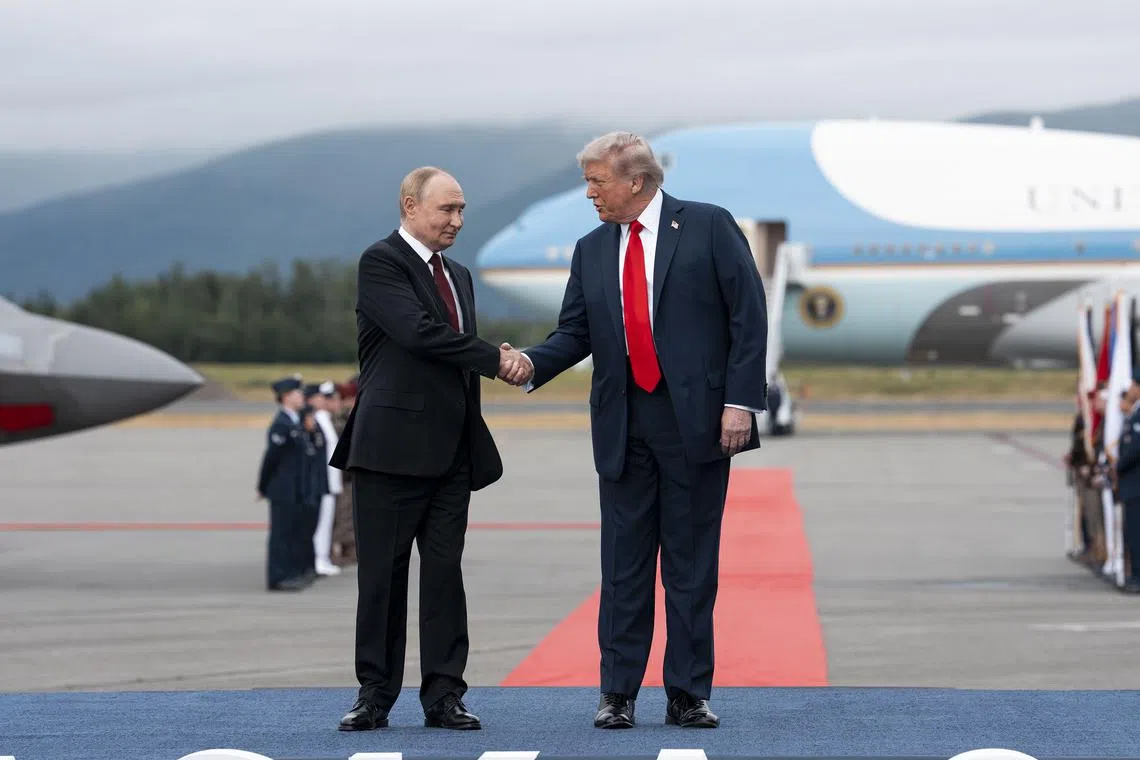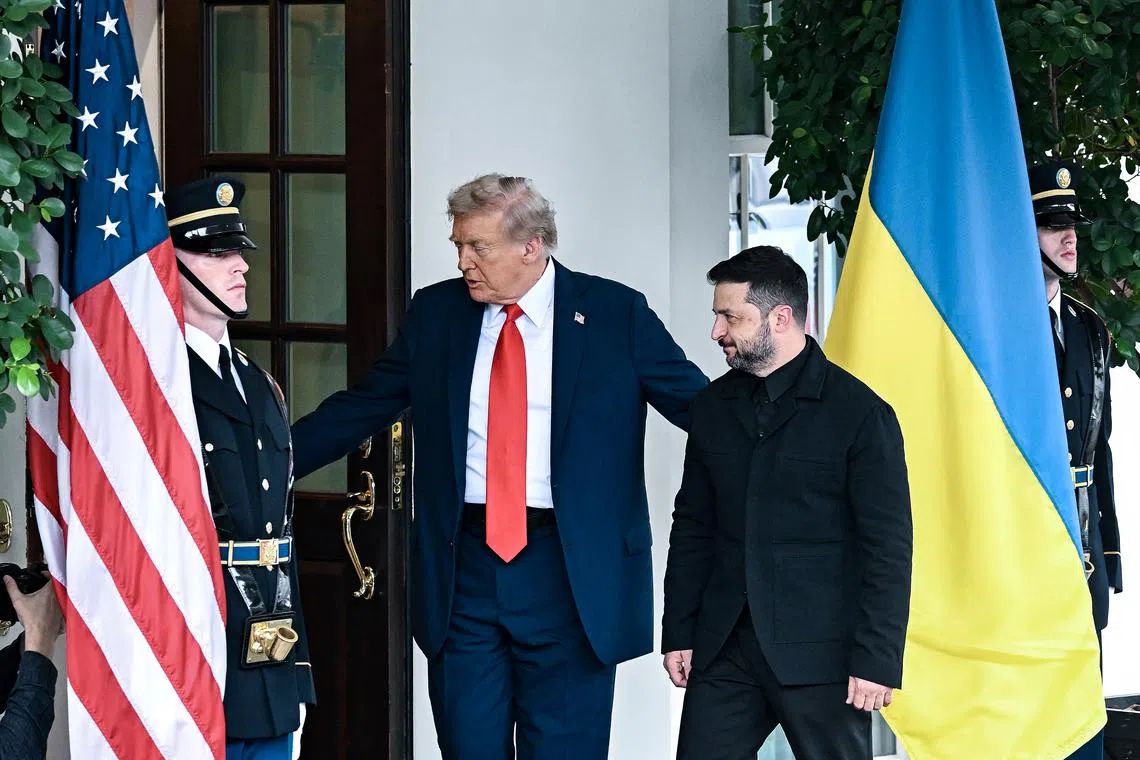What’s next for the Ukraine peace talks?
Sign up now: Get ST's newsletters delivered to your inbox

Russian President Vladimir Putin had agreed with US President Donald Trump only that the level of representation at any talks should be higher than in previous rounds.
PHOTO: DOUG MILLS/NYTIMES
Neil Macfarquhar
Follow topic:
WASHINGTON - For all the extraordinary spectacle involved in US President Donald Trump’s talks with Russia’s President
Mr Trump stressed that his first priority would be to help organise direct talks between Russian President Vladimir Putin and Ukrainian President Volodymyr Zelensky to bring the war in Ukraine to a close.
The US President said that he could then join them for subsequent rounds to help iron out remaining differences.
After emerging from the Oval Office, Mr Zelensky summed up the discussion about a key issue – security guarantees – in a way that could apply to the entire process: “There is still a lot of work to be done.”
When will Zelensky and Putin meet?
Mr Putin has agreed to meet Mr Zelensky in the coming weeks as the next phase of the peace process, said Ms Karoline Leavitt, the White House press secretary, on Aug 19. The US National Security Council is working on a framework, she added.
But Mr Putin had previously stated that he would hold such a meeting only after all the details of a peace treaty were hammered out, and there is no indication that has changed.
State news media in Russia on Aug 19 played down any potential meeting, with Foreign Minister Sergey Lavrov suggesting that it would require intense preparation.
A foreign policy aide to Mr Putin said that the Russian leader had agreed with Mr Trump only that the level of representation at any talks should be higher than in previous rounds.
Mr Zelensky has said that he is ready for talks in any format, and suggested at a news conference in Washington on Aug 18 that it might require pressure from the US to get Mr Putin to attend.
Mr Putin has made it clear that he does not consider Ukraine a viable state, and therefore does not view Mr Zelensky as a worthy interlocutor. On Aug 19, Mr Lavrov dismissively referred to the Ukrainian leader, who first became famous in Russia as a television comedian, as “this character” and “this man”.
During three earlier rounds of talks, Russia sent Mr Vladimir Medinsky, a former culture minister and a Kremlin adviser in anti-Ukraine propaganda efforts, as its lead negotiator – a move that was interpreted as a stick in the eye to Ukraine.
Is Putin using a meeting with Zelensky as a stalling tactic?
Mr Putin has a reputation for slow-walking any crisis, hoping that circumstances will turn more favourable to him.
There is a consensus among war analysts that Mr Putin favours continuing the fighting because he feels that he is winning on the battlefield, and that would give him leverage in future talks, even if the gains are negligible and come with massive loss of life.
Even some Russian analysts expect the Kremlin to suggest at least one more round of negotiations in Istanbul to work on a possible format for a Putin-Zelensky meeting. “Each of these stages can be dragged out endlessly by diplomatic and bureaucratic negotiations, even under American pressure,” Mr Andrei Nikulin, a Russian political commentator, wrote on messaging app Telegram.
What are the ‘security guarantees’ that Ukraine wants?
Mr Trump has said the US would support security guarantees provided by Europe, and that became the focus of the White House talks on Aug 18. While Ukraine and its European allies wanted the first step in any peace process to be a ceasefire, Mr Trump has stressed that an overarching peace plan can be negotiated without a ceasefire.

Mr Putin has agreed to meet Mr Zelensky in the coming weeks as the next phase of the peace process.
PHOTO: DOUG MILLS/NYTIMES
The basic idea of the security guarantees, first broached by Britain and France in February, is that some nations, likely but not necessarily European, would provide soldiers to Ukraine to bolster its forces and create a kind of tripwire that would make Russia hesitate to invade again.
Russia said on Aug 18 that it would refuse any such force from Nato countries.
Ideally, Ukraine wants weapons, foreign troops and an ironclad plan of how another invasion would be parried.
No American soldiers will be deployed to Ukraine, Mr Trump said on Aug 19 on Fox News, but he did not clarify what exactly he would do to support the security guarantees.
“We can certainly help in the coordination, and perhaps provide other means of security guarantees to our European allies,” Ms Leavitt, the White House press secretary, told reporters on Aug 19. “The President understands security guarantees are crucially important to ensure a lasting peace, and he has directed his national security team to coordinate with our friends in Europe and also to continue to cooperate and discuss these matters with Ukraine and Russia as well.”
What are Putin’s red lines?
From the outset, Mr Putin has tried to justify invading Ukraine by accusing the West of using the country, once a pillar of the Soviet Union, as a stalking horse to undermine Russia.
Mr Putin has repeatedly referred to eradicating what he calls the “root causes” of the war in Ukraine – his shorthand for achieving his geopolitical goals – as his red line for ending it.
Those goals include keeping Ukraine out of Nato and preventing the alliance from expanding farther into former Soviet states.
Among his other conditions for ending the war are annexing territory in eastern Ukraine populated mostly by ethnic Russians, ensuring that the Ukrainian military cannot threaten Russia, and that the government in Kyiv is not hostile towards Moscow.
The Russian military largely failed to achieve those outcomes on the battlefield, so Mr Putin is trying to obtain them through negotiations, by leveraging the fact that Russia controls about 20 per cent of Ukrainian territory.
What if the talks collapse?
Having made a campaign promise that he would end the war in Ukraine in 24 hours, Mr Trump has acknowledged in recent days that it was a lot harder than he had expected. Some analysts have suggested that he might just walk away, although the quest for a Nobel Peace Prize is also seen as a factor that keeps him engaged.
French President Emmanuel Macron said after the talks on Aug 18 that new sanctions on Russia and on countries that trade with Russia, as well as new tariffs on Russia or its trading partners, were still possible.
Mr Putin, he noted, has continued to bomb Ukraine even after talking to Trump about peace.
While threatening punishing tariffs against Russia’s trading partners earlier this summer, Mr Trump rowed back the threat after meeting Mr Putin in Alaska on Aug 15. NYTIMES
Ivan Nechepurenko contributed reporting.

